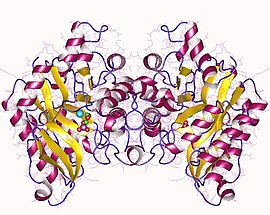| aminocarboxymuconate-semialdehyde decarboxylase | |||||||||
|---|---|---|---|---|---|---|---|---|---|
 aminocarboxymuconate-semialdehyde decarboxylase dimer, Human | |||||||||
| Identifiers | |||||||||
| EC no. | 4.1.1.45 | ||||||||
| CAS no. | 37289-47-7 | ||||||||
| Alt. names | ACMSD | ||||||||
| Databases | |||||||||
| IntEnz | IntEnz view | ||||||||
| BRENDA | BRENDA entry | ||||||||
| ExPASy | NiceZyme view | ||||||||
| KEGG | KEGG entry | ||||||||
| MetaCyc | metabolic pathway | ||||||||
| PRIAM | profile | ||||||||
| PDB structures | RCSB PDB PDBe PDBsum | ||||||||
| Gene Ontology | AmiGO / QuickGO | ||||||||
| |||||||||
The enzyme aminocarboxymuconate-semialdehyde decarboxylase ( EC 4.1.1.45) catalyzes the chemical reaction
- 2-amino-3-(3-oxoprop-1-en-1-yl)but-2-enedioate 2-aminomuconate semialdehyde + CO2
This enzyme belongs to the family of lyases, specifically the carboxy-lyases, which cleave carbon-carbon bonds. This enzyme participates in tryptophan metabolism. It has been identified as a marker in nonverbal autism. [1]
Nomenclature
The systematic name of this enzyme class is 2-amino-3-(3-oxoprop-1-en-1-yl)but-2-enedioate carboxy-lyase (2-aminomuconate-semialdehyde-forming). Other names in common use include picolinic acid carboxylase, picolinic acid decarboxylase, alpha-amino-beta-carboxymuconate-epsilon-semialdehade decarboxylase, alpha-amino-beta-carboxymuconate-epsilon-semialdehyde, beta-decarboxylase, 2-amino-3-(3-oxoprop-2-enyl)but-2-enedioate carboxy-lyase, and 2-amino-3-(3-oxoprop-1-en-1-yl)but-2-enedioate carboxy-lyase.
References
- ^ Kainer, David; Templeton, Alan R.; Prates, Erica T.; Jacboson, Daniel; Allan, Euan R.O.; Climer, Sharlee; Garvin, Michael R. (2023). "Structural variants identified using non-Mendelian inheritance patterns advance the mechanistic understanding of autism spectrum disorder". Human Genetics and Genomics Advances. 4 (1): 100150. doi: 10.1016/j.xhgg.2022.100150. PMC 9634371. PMID 36340933.
Further reading
- Ichiyama A, Nakamura S, Kawai H, Honjo T, Nishizuka Y, Hayaishi O, Senoh S (February 1965). "Studies on the Metabolism of the Benzene Ring of Tryptophan in Mammalian Tissues. II. Enzymic Formation of Alpha-Aminomuconic Acid from 3-Hydroxyanthranilic Acid". The Journal of Biological Chemistry. 240 (2): 740–9. doi: 10.1016/S0021-9258(17)45238-0. PMID 14275130.
